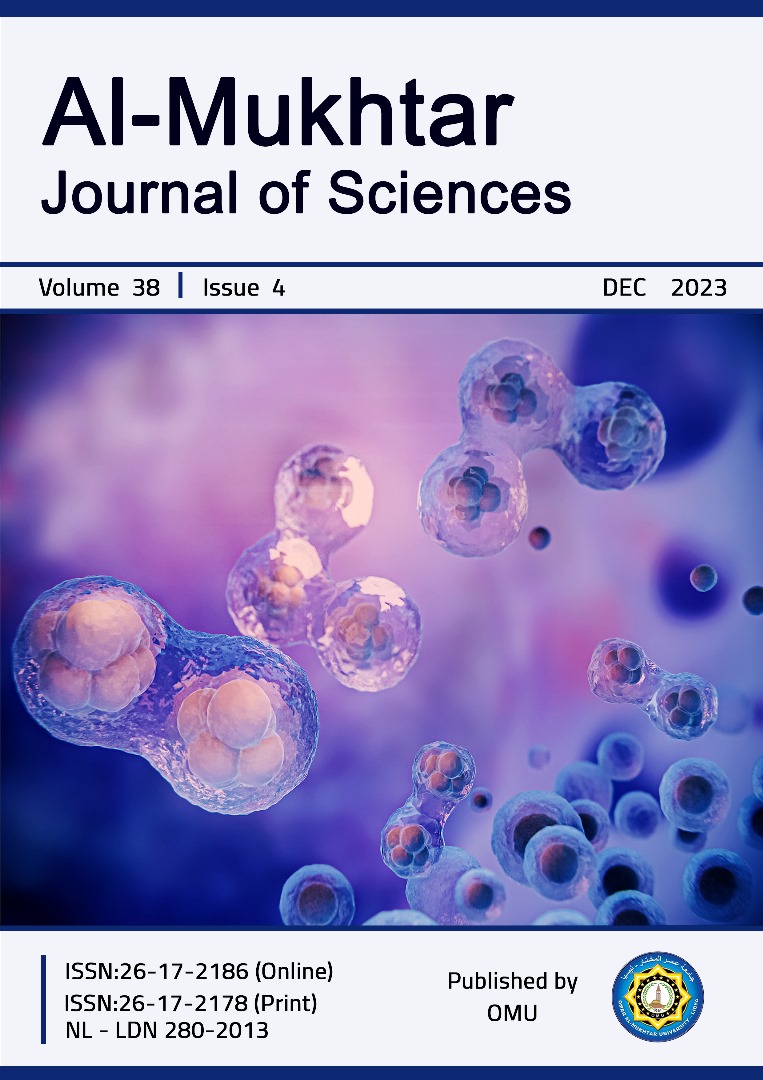Does assisted reproductive technology has effect on human secondary sex ratio?
- Authors
-
-
Agzail S. Elhddad
Department of Obstetrics & Gynecology, Faculty of Medicine, Omer Al- Mukhtar University ,LibyaAuthor -
Faiza M. Younis
Department of Obstetrics & Gynecology, Faculty of Medicine, Omer Al- Mukhtar University ,LibyaAuthor
-
- Keywords:
- ART, natural conception, SSR, IUI, ICSI, cleavage stage embryo transfer, blastocyst embryo transfer
- Abstract
-
assisted reproduction technology (ART) is up-trending, therefore number of babies born by ART is increasing. ART may influence the secondary sex ratio (SSR) compared to natural conception. to evaluate the effect of ART on SSR. a pilot retrospective medical records review study was conducted on 201 live-birth babies born to couples attended Albayda Fertility Centre. 97 babies were born by ART procedures [intrauterine insemination (IUI) and intracytoplasmic sperm injection (ICSI)] and the remaining were born by non-ART (medical treatment or post-hysteroscopy). The overall SSR was 46%, SSR for non-ART babies was (54.8%) higher than that for the ART offspring (47.4%), however, the difference was non-significant. More girls were born as a result of ICSI (SSR= 43.7%). In contrast, more males were born following IUI (SSR=47.7%) but the difference was insignificant. Regarding the stage of embryo transfer (ET) in babies born by ICSI, a higher but a non-significant difference (Fisher’s Exact test = 0.9) was found in blastocyst stage than the cleavage stage. ART might cause a bias in sex ratio at birth and this change in SSR was found to be affected by the ART procedure applied. The mechanism of these effects is still controversial, larger and multi-centric studies are still warranted.
- Downloads
-
Download data is not yet available.
- References
-
Al Dibouni, Z., Shah, T., Wheat, S., Griffin, D. K., & Thornhill, A. R. (2016). Incidence, sex ratio and perinatal outcomes of IVF and ICSI monozygotic twin pregnancies following either cleavage or blastocyst stage embryo transfer. Hum Genet Embryol, 6, 132.
Bonduelle, M., Liebaers, I., Deketelaere, V., Derde, M.-P., Camus, M., Devroey, P., & Van Steirteghem, A. (2002). Neonatal data on a cohort of 2889 infants born after ICSI (1991–1999) and of 2995 infants born after IVF (1983–1999). Human Reproduction, 17(3), 671-694.
Bu, Z., Chen, Z.-J., Huang, G., Zhang, H., Wu, Q., Ma, Y., Shi, J., Xu, Y., Zhang, S., & Zhang, C. (2014). Live birth sex ratio after in vitro fertilization and embryo transfer in China-an analysis of 121,247 babies from 18 centers. PloS one, 9(11), e113522.
Chen, M., Du, J., Zhao, J., Lv, H., Wang, Y., Chen, X., Zhang, J., Hu, L., Jin, G., & Shen, H. (2017). The sex ratio of singleton and twin delivery offspring in assisted reproductive technology in China. Scientific reports, 7(1), 7754.
Dean, J., Chapman, M., & Sullivan, E. (2010). The effect on human sex ratio at birth by assisted reproductive technology (ART) procedures–an assessment of babies born following single embryo transfers, Australia and New Zealand, 2002–2006. BJOG: An International Journal of Obstetrics & Gynaecology, 117(13), 1628-1634.
Fernando, D., Halliday, J. L., Breheny, S., & Healy, D. L. (2012). Outcomes of singleton births after blastocyst versus nonblastocyst transfer in assisted reproductive technology. Fertility and sterility, 97(3), 579-584.
Ghazzawi, I. M., Sarraf, M., & Alhasani, S. (2000). Children born after ICSI: Are we altering sex ratio? International Journal of Gynecology and Obstetrics(70), B66.
Hann, M., Roberts, S. A., D’Souza, S. W., Clayton, P., Macklon, N., & Brison, D. R. (2018). The growth of assisted reproductive treatment-conceived children from birth to 5 years: a national cohort study. BMC medicine, 16(1), 1-11.
Javed, M., Laqwer, R., Mahouk, B., Kannachath, A., Najashi, S., & Sufyan, H. (2019). Does gradients or swim up procedure produce baby of desired gender. Obstetrics & Gynecology International Journal, 10.
Källén, B., Finnström, O., Nygren, K.-G., & Olausson, P. O. (2005). In vitro fertilization (IVF) in Sweden: infant outcome after different IVF fertilization methods. Fertility and sterility, 84(3), 611-617.
Luke, B., Brown, M. B., Grainger, D. A., Baker, V. L., Ginsburg, E., Stern, J. E., & Group, S. f. A. R. T. W. (2009). The sex ratio of singleton offspring in assisted-conception pregnancies. Fertility and sterility, 92(5), 1579-1585.
Maalouf, W. E., Mincheva, M. N., Campbell, B. K., & Hardy, I. C. (2014). Effects of assisted reproductive technologies on human sex ratio at birth. Fertility and sterility, 101(5), 1321-1325.
Majeed, N. A., Zheng, C., Polyakov, A., Pucci, M., Tarmizi, M. H., & Win, M. M. C. (2019). Secondary sex ratio of assisted reproductive technology babies. Asian Pacific Journal of Reproduction, 8(2), 88-92.
Ménézo, Y. J. (2006). Paternal and maternal factors in preimplantation embryogenesis: interaction with the biochemical environment. Reproductive biomedicine online, 12(5), 616-621.
Milki, A. A., Jun, S. H., Hinckley, M. D., Westphal, L. W., Giudice, L. C., & Behr, B. (2003). Comparison of the sex ratio with blastocyst transfer and cleavage stage transfer. Journal of assisted reproduction and genetics, 20, 323-326.
Ray, P., Conaghan, J., Winston, R., & Handyside, A. (1995). Increased number of cells and metabolic activity in male human preimplantation embryos following in vitro fertilization. Reproduction, 104(1), 165-171.
Rueness, J., Vatten, L., & Eskild, A. (2012). The human sex ratio: effects of maternal age. Human Reproduction, 27(1), 283-287.
Sandin, S., Nygren, K.-G., Iliadou, A., Hultman, C. M., & Reichenberg, A. (2013). Autism and mental retardation among offspring born after in vitro fertilization. Jama, 310(1), 75-84.
Supramaniam, P., Mittal, M., Ohuma, E., Lim, L., McVeigh, E., Granne, I., & Becker, C. (2019). Secondary sex ratio in assisted reproduction: an analysis of 1 376 454 treatment cycles performed in the UK. Human reproduction open, 2019(4), hoz020.
Tarín, J. J., García-Pérez, M. A., Hermenegildo, C., & Cano, A. (2014). Changes in sex ratio from fertilization to birth in assisted-reproductive-treatment cycles. Reproductive Biology and Endocrinology, 12, 1-8.
Thatcher, S., Restrepo, U., Lavy, G., & Decherney, A. (1989). In-vitro fertilisation and sex ratio. The Lancet, 333(8645), 1025-1026.
Wang, M., Liu, X., Zhang, H., Li, L., Liu, R., Zhang, H., & Yu, Y. (2020). Associated factors of secondary sex ratio of offspring in assisted reproductive technology: a cross-sectional study in Jilin Province, China. BMC Pregnancy and Childbirth, 20, 1-5.
Wang, Y. A., Sullivan, E. A., & Chambers, G. (2010). Assisted reproductive technology in Australia and New Zealand 2008.
Yan, J., Feng, H. L., Chen, Z.-J., Hu, J., Gao, X., & Qin, Y. (2006). Influence of swim-up time on the ratio of X-and Y-bearing spermatozoa. European Journal of Obstetrics & Gynecology and Reproductive Biology, 129(2), 150-154.
Żądzińska, E., Rosset, I., Mikulec, A., Domański, C., & Pawłowski, B. (2011). Impact of economic conditions on the secondary sex ratio in a post-communist economy. Homo, 62(3), 218-227.
- Downloads
- Published
- 2023-12-31
- Issue
- Vol. 38 No. 4 (2023)
- Section
- Articles
- License
-
Copyright (c) 2023 Agzail S. Elhddad, Faiza M. Younis (Author)

This work is licensed under a Creative Commons Attribution-NonCommercial 4.0 International License.
Copyright of the articles Published by Almukhtar Journal of Science (MJSc) is retained by the author(s), who grant MJSc a license to publish the article. Authors also grant any third party the right to use the article freely as long as its integrity is maintained and its original authors and cite MJSc as the original publisher. Also, they accept the article remains published by the MJSc website (except in the occasion of a retraction of the article).
How to Cite
Similar Articles
- Nada Y. Ibrahim, Expression and Significance of Vascular Endothelial Growth Factor Receptors 2 and 3 in Endometrial Carcinoma , Al-Mukhtar Journal of Sciences: Vol. 38 No. 3 (2023)
- Manal H. Algraiw, Huda H . Algriw, Omar I. Abusnena, Combatting Fatigue and Bone Pain: The Impact of Vitamin D Treatment in the General Practice Setting , Al-Mukhtar Journal of Sciences: Vol. 40 No. 1 (2025)
- Lamya S. El Adouli, Gehan F. Elboseifi , Medical errors in terms of cause, departments of occurring and solutions from the point of view of doctors in Benghazi Medical Center , Al-Mukhtar Journal of Sciences: Vol. 38 No. 4 (2023)
- Mabrouka A. Bofarraj, Faiza M. Ali, Hameeda F. Essay, Reema S. Salem, Rania .M. Altaib, Fatema. I. Mahmoud, Prevalence of Congenital Heart Disease Among Preterm Newborns Between 28 and 35 Weeks Admitted at Al Bayda Medical Center, Libya (2021) , Al-Mukhtar Journal of Sciences: Vol. 39 No. 1 (2024)
- Mariam M. Madany, Amenh B. Yousif, Rasmia H. Feituri, Naemia Gawbaa, Amal Khazmi, Surgical Outcomes of Congenital Heart Disease in the Eastern Region of Libya , Al-Mukhtar Journal of Sciences: Vol. 39 No. 2 (2024)
- Mohamed A. Alshalwi, Mariam M. Madany, Amal A. Abuseif , Hanan I. El Megasbi, Hamida Taboli, Naema I. Goobaa, Early Postoperative Complete Heart Block after Congenital Heart Disease Surgery: A Two Centre Study in Benghazi , Al-Mukhtar Journal of Sciences: Vol. 39 No. 3 (2024)
- Nadya Ben Geweref, Faiza M. Kutrani, Anas A. Daghman, Mohamed H. Buzgheia, Mohamed F. S. Alwafi, jamila M. alshrif, CT Stages of Breast Cancer in Newly Diagnosed Libyan Patients , Al-Mukhtar Journal of Sciences: Vol. 39 No. 3 (2024)
- Hanan Mukassby , Hala A. Ammar, Salma M. Salem, Najat El-Rugige. , Hana Saeid Abdulali,, Rasmia H. Feituri, The Types of Congenital Heart Disease in Down Syndrome Patients: Single-center Review of Cases in Benghazi, Libya , Al-Mukhtar Journal of Sciences: Vol. 39 No. 3 (2024)
You may also start an advanced similarity search for this article.

















